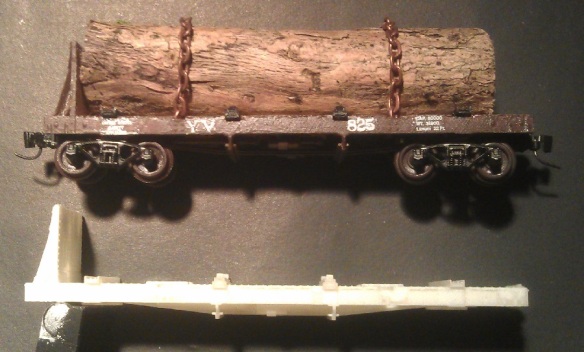Now the prints have arrived it’s time to clean them up and get them ready for painting. Actually I’ve had 3 versions of the log car printed so far with each being an improvement on the last. The first was very short on detail, due to some modeling errors which have now all been fixed. The second came out very well although I was unhappy with the deck planks all being exactly the same length; this caused the plank detail to disappear and the model looked too square and a little unrealistic. The third and current version looks fantastic, although when I opened the box from Shapeways I could see there was a problem. There was a bow in the main deck of the car. I have had this before with other prints and it has resolved itself during the cleaning process. (please see my FAQs for more information on the cleaning process).
All the parts where put into a jar containing Goo Gone to remove the wax residue as normal. I was hoping this might help soften the FUD material and fix the problem but unfortunately this time it increased it. Here is the car after the cleaning process was complete.
So why does this happen? Well the FUD material is printed along with a wax that supports the delicate parts as the print is developed layer by layer. Once the print run is complete the parts are put into an oven to melt away the wax. When the parts are removed and left to cool, one side will cool quicker than the other, and because this car is long and thin it will cause it to curl, very similar to the effect caused by heating and cooling a Bimetallic strip.
Although the Goo Gone softened the FUD material it was not enough to undo this effect, and leaving it to dry again caused the bow to increase. However this can be removed from the model by using hot water. Water at 150F (66°) will bring the model back to the temperature of the oven and the bend can be reshaped and as it cools it will hold the new shape. For this log car, after making a cup of tea and letting the water in the kettle cool for a few minutes, I poured a small amount of the hot water over the middle of the car. Almost at once it became softer and flexible, the bend straightened without any effort and I held the car in my fingers as it cooled and became ridged again. In the photo below, the lower car is the one that had the bow in it.
 I had to be careful as it cooled not to let the effect make the car bow the other way, if this did happen I could simply pour on a bit more hot water. I will now leave the car to totally dry overnight, checking that the bow does not come back.
I had to be careful as it cooled not to let the effect make the car bow the other way, if this did happen I could simply pour on a bit more hot water. I will now leave the car to totally dry overnight, checking that the bow does not come back.
In the next post we will look at painting and decaling the car.





 Details such as the diagonal angle irons which support the bulk head needed to be made into solid triangles, and the gaps between the deck planks needed to be enlarged otherwise they would disappear when the model is painted.
Details such as the diagonal angle irons which support the bulk head needed to be made into solid triangles, and the gaps between the deck planks needed to be enlarged otherwise they would disappear when the model is painted.






























You must be logged in to post a comment.